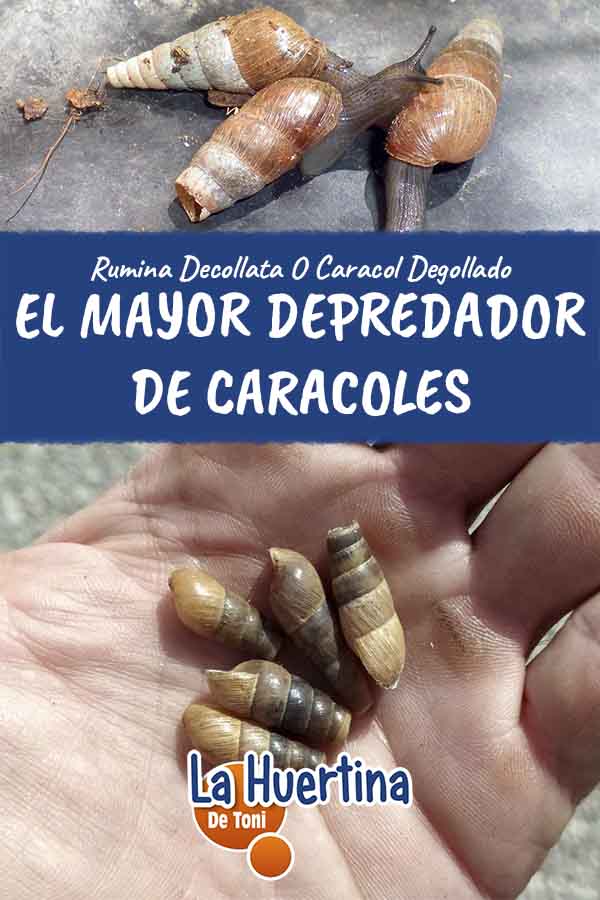The cutthroat snail (Rumina decollata) is a species of snail native to the Mediterranean that has been introduced throughout history to other parts of the world such as North America. He’s a predator eats snailsslugs and their eggs, today we are going to learn a little more about this species and if it is good for the garden.


Contents
Getting to Know the Snail Slaughtered
It is a snail known as Rumina decollata and can be found in Argentina, throughout the Mediterranean region, North America, Canada, the Canary Islands and Mexico, among other places. In many places it was intentionally introduced for the crop pest control such as snails and slugs, although it has also been accidentally introduced through gardening.
Rumina decollata is a nocturnal species who likes to go out with very humid environments although it can be found during the day if it rains. Normally, it is hidden underground if there are inadequate conditions such as too hot or too cold, being able to survive these extreme climates.
To offer

Neudorff – Antilimaco Ferramol 0.5 Kg
- Security period: 0 days. You can harvest the crop after its application.
- Non-toxic to pets and auxiliary wildlife.
- Contains 500gr
- Won’t dissolve in the rain
- Biodegradable
Food, what are you eating?
Rumina decollata feeds mainly on snails, slugs, eggs, although if it has no prey it usually feeds on carcasses it can find of insects, organic matter such as leaves dead lettuce or cabbage, and if he finds nothing to eat, then directly attack crops.

From my experience I can say that in my urban garden there is Rumina decollata and the truth is that I don’t have a single slug because my lettuce is without a hole. I usually watch them at night as they eat fallen leaves on the ground or whatever straw padding I have.
Habitat
It can be found under stones, in cracks, under leaves or wandering around the garden. It also likes to hide under creeping plants where it feeds on dead leaves, an example is the sweet potato.
Ally or Enemy?
Everyone knows that any species that is not in its natural habitat poses a risk to other local species and if you live in a rural area where this snail is not present, better not release it because it can extinguish local species. It can even become a pest but it is not as harmful to agriculture as the slugs and snails which devastate crops. If the Rumina decollata is already present in your garden, you can take advantage of its advantages and if there are too many copies, they can be easily controlled so that there are no excess individuals.

Fight it if necessary
Is Rumilla decollata a pest? Although it will not cause as much damage to the harvest, many people are afraid of seeing so many and want to fight them without knowing their benefits. You can still control their population.
Like its “cousins” the snails and slugs, the snail Rumina decollata is attracted by the smell of beer, thus being able to set traps with pet bottles. You can also place orange zest under the tiles, the decapitated snail will be attracted by the smell and you can capture it when it hides under the tiles.
To offer

Neudorff – Antilimaco Ferramol 0.5 Kg
- Security period: 0 days. You can harvest the crop after its application.
- Non-toxic to pets and auxiliary wildlife.
- Contains 500gr
- Won’t dissolve in the rain
- Biodegradable
Any trap that we use to fight the snails will also serve to fight the decapitated snail, so we must be careful if we do not want to capture them.
What do you think ? Was this article helpful to you? Yes Do you have doubts Where do you want leave a comment you can enter the forum and if it works for you you can still support the channel with a donation or help me spread it, by sharing it on social networks. If you want to follow me, here are some of the social networks I use Facebook , instagram , pinterest Where subscribe to my youtube channel
HERE I LEAVE YOU A POSTER IN CASE YOU WANT TO SAVE IT ON PINTEREST
